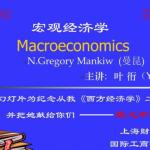曼昆宏观经济学单词名词解释英文版(3)
本站小编 kidczw/2019-12-19
Keynesian cross: A simple model of income determination, based on the ideas in Keyness Gen-eral Theory, which shows how changes in spending can have a multiplied e.ect on aggregate income.
Keynesian model: A model derived from the ideas of Keyness General Theory; a model based on the assumptions that wages and prices do not adjust to clear markets and that aggregate demand
47
determines the economys output and employment. (Cf. classical model.)
Government-purchases multiplier: The change in aggregate income resulting from a one-dollar change in government purchases.
Tax multiplier: The change in aggregate in-come resulting from a one-dollar change in taxes.
Theory of liquidity preference: A simple model of the interest rate, based on the ideas in Keyness General Theory, which says that the in-terest rate adjusts to equilibrate the supply and demand for real money balances.
Chapter 12
Unit twelve
Monetary transmission mechanism: The process by which changes in the money supply in-.uence the amount that households and .rms wish to spend on goods and services.
Pigou e.ect: The increase in consumer spend-ing that results when a fall in the price level rais-es real money balances and, thereby, consumers wealth.
Debt-de.ation theory: A theory according to which an unexpected fall in the price level redis-tributes real wealth from debtors to creditors and, therefore, reduces total spending in the economy.
49
Chapter 13
Unit thirteen
MundellCFleming model: The ISCLM mod-el for a small open economy.
Floating exchange rate: An exchange rate that the central bank allows to change in response to changing economic conditions and economic poli-cies. (Cf. .xed exchange rate.)
Fixed exchange rate: An exchange rate that is set by the central banks willingness to buy and sell the domestic currency for foreign currencies at a predetermined price. (Cf. .oating exchange rate.)
51
Devaluation: An action by the central bank to decrease the value of a currency under a system of .xed exchange rates. (Cf. revaluation.)
Revaluation: An action undertaken by the central bank to raise the value of a currency under a system of .xed exchange rates. (Cf. devalua-tion.)
Speculative attack: The massive selling of a countrys currency, often because of a change in in-vestors perceptions, that renders a .xed exchange rate untenable.
Currency board: A .xed exchange rate sys-tem under which a central bank backs all of the na-tions currency with the currency of another coun-try.
Dollarization: The adoption of the U.S. dol-lar as the currency in another country.
Impossible trinity: The fact that a nation cannot simultaneously have free capital .ows, a .xed exchange rate, and independent monetary policy. Sometimes called the trilemma of inter-national .nance.
Chapter 14
Unit fourteen
Sticky-price model: The model of aggregate supply emphasizing the slow adjustment of the prices of goods and services.
Imperfect-information model: The model of aggregate supply emphasizing that individuals do not always know the overall price level because they cannot observe the prices of all goods and ser-vices in the economy.
Phillips curve: A negative relationship be-tween in.ation and unemployment; in its modern form, a relationship among in.ation, cyclical un-employment, expected in.ation, and supply shock-s, derived from the short-run aggregate supply curve.
55
Adaptive expectations: An approach that assumes that people form their expectation of a variable based on recently observed values of the variable. (Cf. rational expectations.)
Demand-pull in.ation: In.ation resulting from shocks to aggregate demand. (Cf. cost-push in.ation.)
Cost-push in.ation: In.ation resulting from shock-s to aggregate supply. (Cf. demand-pull in.ation.)
Sacri.ce ratio: The number of percentage points of a years real GDP that must be forgone to reduce in.ation by 1 percentage point.
Rational expectations: An approach that assumes that people optimally use all available in-formation including information about current and prospective policiesto forecast the future. (Cf. adap-tive expectations.)
Natural-rate hypothesis: The premise that .uctuations in aggregate demand in.uence output, employment, and unemployment only in the short run, and that in the long run these variables return to the levels implied by the classical model.
Hysteresis: The long-lasting in.uence of his-tory, such as on the natural rate of unemployment.
相关话题/宏观经济学
罗默高级宏观经济学考研复习笔记部分章节(图文)
经济管理金融贸易笔记 卡卡 网络资源 2019-12-01尹敬东中级宏观经济学教程部分计算题答案
专业课考研资料 SKr狠熊 网络资源 2019-12-012020年西南财经大学802经济学二(宏观经济学部分)考试大纲解析
目录封面内容简介目录专题一:宏观经济总量:GDP和价格指数 第一部分 考纲要求 第二部分 考试大纲详解 第三部分 章节考研真题详解专题二:简单的凯恩斯主义模型 第一部分 考纲要求 第二部分 考试大纲详解 第三部分 章节考研真题详解专题三:扩大的凯恩斯主义模型 第一部分 考纲要求 第二部分 考试大纲详 ...辅导考试考研资料 本站小编 Free考研 2019-10-032020年西南财经大学801经济学一(宏观经济学部分)考试大纲解析
目录封面内容简介目录专题一:GDP和价格指数 第一部分 考纲要求 第二部分 考试大纲详解 第三部分 章节考研真题详解专题二:简单的凯恩斯主义模型 第一部分 考纲要求 第二部分 考试大纲详解 第三部分 章节考研真题详解专题三:扩大的凯恩斯主义模型 第一部分 考纲要求 第二部分 考试大纲详解 第三部分 ...辅导考试考研资料 本站小编 Free考研 2019-10-03中山大学801微观经济学与宏观经济学历年考研真题视频讲解【12小时高清视频】
目录封面内容简介目录2009年中山大学801微观经济学与宏观经济学考研真题综合分析[视频详解]2009年中山大学801微观经济学与宏观经济学考研真题2009年中山大学801微观经济学与宏观经济学考研真题详解[视频详解]2010年中山大学801微观经济学与宏观经济学考研真题综合分析[视频详解]2010 ...辅导考试考研资料 本站小编 Free考研 2019-10-03重庆大学经济与工商管理学院804微观经济学(含宏观经济学)历年考研真题汇编(含部分答案)
目录封面内容简介目录2003年重庆大学408微观经济学(含宏观经济学)考研真题2004年重庆大学408微观经济学(含宏观经济学)考研真题2005年重庆大学408微观经济学(含宏观经济学)考研真题2006年重庆大学408微观经济学(含宏观经济学)考研真题2007年重庆大学406微观经济学(含宏观经济学 ...辅导考试考研资料 本站小编 Free考研 2019-10-03西安电子科技大学经济与管理学院861经济学(宏观经济学、微观经济学各占50%)历年考研真题汇编
目录封面内容简介目录2007年西安电子科技大学861经济学(宏观经济学、微观经济学各占50%)考研真题2008年西安电子科技大学861经济学(宏观经济学、微观经济学各占50%)考研真题2009年西安电子科技大学861经济学(宏观经济学、微观经济学各占50%)考研真题2010年西安电子科技大学861经 ...辅导考试考研资料 本站小编 Free考研 2019-10-03中山大学国际金融学院经济学(含微观和宏观经济学)历年考研真题及详解
目录封面内容简介目录2011年中山大学899经济学(含微观和宏观经济学)考研真题2011年中山大学899经济学(含微观和宏观经济学)考研真题及详解2012年中山大学894经济学(含微观和宏观经济学)考研真题2012年中山大学894经济学(含微观和宏观经济学)考研真题及详解2013年中山大学893经济 ...辅导考试考研资料 本站小编 Free考研 2019-10-03华东师范大学849经济学原理(微观、宏观经济学)历年考研真题汇编(含部分答案)
目录封面内容简介目录1996年华东师范大学商学院西方经济学考研真题1998年华东师范大学商学院西方经济学(微观、宏观经济)考研真题1999年华东师范大学商学院西方经济学(微观、宏观经济)考研真题2001年华东师范大学商学院449西方经济学考研真题2002年华东师范大学商学院449西方经济学考研真题及 ...辅导考试考研资料 本站小编 Free考研 2019-10-03[2019初试真题回忆] 2019年中山大学微观经济学与宏观经济学专业真题回忆(801)
2019年中山大学801微观经济学与宏观经济学考研真题最全回忆版首发!!!(2)若对汽车厂商出售的每辆汽车征收10单位的税收,问市场上的汽车价格和交易数量是多少,征税的纯损失是多少(3)若限制汽车的最低限价为90,此时汽车的交易量是多少,市场的最低限价的纯损失是多少?(4)若国外市场进口的汽车价格为 ...专业课考研资料 本站小编 Free考研网 2019-05-28[2019初试真题回忆] 2019年南京财经大学微观、宏观经济学初试真题回忆(812)
2019年南财812微观经济学宏观经济学第一部分微观经济学一名词解释规模报酬外部影响边际转换率二简答题①解释既定成本下产量最大化,使得最后一单位的成本支出无论用来购买哪一种生产要素所获得的边际产量都相等,结合图形或数学证明②三级价格歧视下要求厂商在需求价格弹性小的市场上制定较高的产品价格,在需求的价 ...专业课考研资料 本站小编 Free考研网 2019-05-282018年北京师范大学经管院910微观与宏观经济学超详细经验分享
初试科目:政治,英语一,数学三,微观与宏观经济学。站在别人的肩膀上,可以让你少走很多弯路,需要提醒大家的是,数学的备考一定要下足功夫,实属拉分科目,政治建议大家看视频,自学很枯燥且容易抓不住重点。专业课:下边我重点说一下专业课910微观与宏观经济学的备考:参考书目:范里安的微观经济学现代观点,伯南克 ...考研报考信息 本站小编 Free考研网 2019-05-28西南财经大学宏观经济学笔记[曾志远] (图文)
![西南财经大学宏观经济学笔记[曾志远] (图文)](/d/file/2019/04-14/small036140dda28338f8bf3bf78e8508fd7a1555203601.jpg) .. ...专业课考研资料 本站小编 免费考研网 2019-04-14
.. ...专业课考研资料 本站小编 免费考研网 2019-04-14上海财经大学宏观经济学课件 叶衎
 .. ...专业课考研资料 本站小编 免费考研网 2019-04-11
.. ...专业课考研资料 本站小编 免费考研网 2019-04-11厦门大学西方经济学宏观经济学统考复习讲义
第二部分考点串讲 (宏观经济学部分) 第1篇导言 第1章宏观经济学的科学 一、 本章概述 宏观经济学侧璽从总体角度考察经济,研究诸如经济増长、物价总水平变动 &通货膨胀)、失业、政府政策选择等问题.本章我们将学习①宏观经济学 的研究工具:经济模型;②价格伸缩性和价格粘性的概念及其区别;③宏微 观经济学的 ...专业课考研资料 本站小编 免费考研网 2019-04-11
